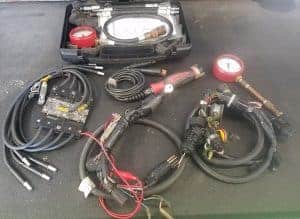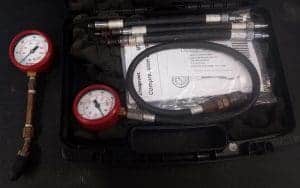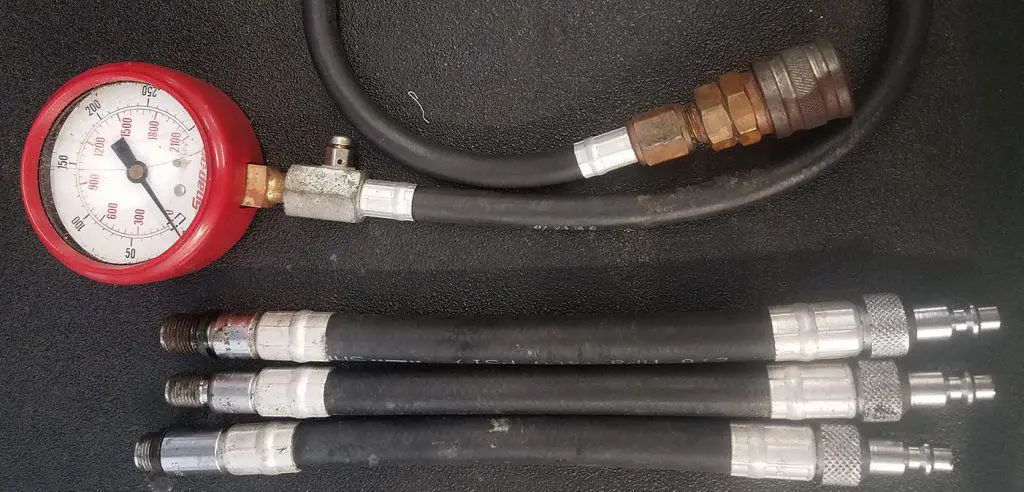The first thing that most people think of when they hear the words, “compression test,” is expensive. Is that really the case though?
What Outboard Compression Test Results Mean. Results vary depending on whether the outboard is a Four-Stroke or a Two-Stroke. Good results for Four-Strokes should be 180-210 PSI, and Two-Strokes should be around 110-130 PSI.
Here is everything that you need to know about outboard compression tests. How to do them and what the results mean for you!
What Is A Compression Test?
A compression test for an outboard is a simple test that can be performed on any combustion engine. It is the very basic test that can provide the tester with the viability of the engine itself.
It will prove whether the engine has a good powerhead or not. As in any combustion engine, the power of the engine is made when a piston moves upward in a cylinder. Compressing a fuel and air mixture to a certain point, and then setting it on fire.
When the mixture explodes inside of the cylinder, it will push the piston back down. Driving the pistons of other cylinders up and then doing this in a specific sequence to keep all of the pistons going up and down and creating the power of the engine.
What the power is used for depends on what the engine is placed in. In a car, it will turn the transmission and then, in turn, spin the wheels of the car around.
For us in the boating world. It will turn the gears in the lower unit, which transforms this motion to the propeller. That drives the boat forward. (Check this out for more information on The Different Sections of an Outboard Engine!)
What the compression test tells us, is what kind of shape the mechanics of the engine are in. Whether or not the engine is creating the proper amount of compression to run properly.
What Do You Need To Perform A Compression Test?
 Depending on what brand of engine and what kind of engine you are trying to test. Will determine what tools you will need.
Depending on what brand of engine and what kind of engine you are trying to test. Will determine what tools you will need.
You will need a basic set of sockets and a wrench to remove any kind of plastics or covers that protect the ignition coils. You will need your socket sets to remove the coils and expose the spark plugs.
The next tool you will need is the correct deep well socket that will get the spark plugs out.
This is where you will need a couple of specific tools. There are really only two things you will need once you get to this point.
You will need a compression tester, and a way to turn the engine over. We have a couple of compression testers that you can get from Amazon on our resources page here.
Or you can always go down to your local auto store, napa, advanced auto, AutoZone, or whatever is in your area. Usually, you can find a decent compression tester for under $50 at any of these places.
Most compression testers come with several hoses with a variation of fittings on the ends of them that will fit the most common spark plug threads on almost all manufacturers. As long as it fits your engine, you are good to go! They are pretty standard :)
Bringing us to the next tool that you will need. Depending on the brand and manufacturer of the engine, it will determine what you can do at this point. If you are by yourself, you are going to want a remote key switch or a starter button. (We recommend a couple of starter buttons here.)
This will allow you to turn the engine over to get the results from the compression test.
Another way is to have someone turn the key over, again depending on what kind of engine you are doing this on. You will need to be careful because some engines have features that will continue turning the engine over. Even when you don’t want too!
How Do You Do A Compression Test On An Outboard Motor?
Performing the compression test is actually a pretty simple process. You are going to want to take off any of those covers that we talked about earlier from over the top of the ignition coils. Once you are looking at your engine and you get the ignition coils exposed. You want to take out the bolts that are holding the coils in.
If there aren’t any covers or bolts, great! Just pull the spark plug wires off of the spark plugs, and then using the correct socket for your plugs. Remove all of the spark plugs.
Now you can take your compression tester and thread the hose into any cylinder that you want to start with.
Take your remote start button and hook up to the starter solenoid on the engine. Now you can jump the solenoid using your button and turn the engine over while looking at the gauge.
Continue turning the engine over until the compression gauge levels off up at the top. This should only take 5-10 revolutions of the engine, and the gauge should stop going up. There isn’t any need to continue holding the button to see just how much more you can get.
The top is the top and the last 5 pounds or so isn’t going to matter! :)
Which brings us to another question about how to perform the test.
Should You Do An Outboard Compression Test Hot or Cold?
 This is another one of those “controversial” subjects. Both sides will fight to the death of which is right and which is wrong. They both have different aspects to them that make them beneficial.
This is another one of those “controversial” subjects. Both sides will fight to the death of which is right and which is wrong. They both have different aspects to them that make them beneficial.
In my personal opinion, and experience of having performed possibly up into the thousands of compression tests. That it is most definitely better to do the compression test with a little warmth to the engine.
At the same time though, what are you going to do when the engine doesn’t run? If it doesn’t run, it won’t get hot. If it won’t get hot, do you skip the compression test and start testing other components of the engine?
This rings especially true when you are performing compression tests with purpose. When you are being paid to troubleshoot and figure out a problem. You will find that in most cases, the whole story hasn’t been told to you.
Someone might say, the engine won’t run, it was running fine. Forgetting to tell you that they were backing down on a sailfish and the engine was partially submerged underwater!
So the hot and cold thing can go either way. Having the engine warm and getting oil up into the cylinders sealing the rings and valves better. Will change the results of your compression test. So, if you do the test while the engine is hot. You will get the best readings.
Though performing the compression test on a cold engine will still get you close to the right readings.
What Is A Good Compression Test Reading or Result?
You might be wondering this question, as I’ve had to answer it many times over the years to newer mechanics and boaters. Which is a great thing to me, because it shows a person’s willingness to learn!
Compression test results will vary depending on what kind of engine you are working on. Mainly, there is a big difference between Two-Strokes and Four-Strokes.
As we stated earlier at the beginning of this article. Two-Stroke engines should have a compression reading of around 110-130 PSI. Sometimes having compression as low as 80 and 90, the engine will still run great! We’ll talk about low results in a minute.
Now the Four-Strokes have more moving parts. They don’t have ports like on the Two-Strokes. Instead, they have intake and exhaust valves that also need to close, and they have a much higher compression reading.
Four-Stroke results should be somewhere in the 180-210 PSI range. These are good readings. Now it is important to note here that you might see 150 or 160 PSI on certain engines when doing this test.
Simply open up the throttle plates by pressing the throttle handles on the control box to wide-open throttle in neutral.
This will allow more air into the system, and you should see the readings come up to that 180 or so range.
These are the best results for a sound, and mechanically solid engine.
Compression Testing A Yamaha, Evinrude, Mariner, Mercury, Suzuki, or Honda
I want to throw this in here because it really doesn’t matter what manufacturer or brand engine you have. The compression test and test results are going to be the same!
Some people will say differently, but when we get down to it. An engine is an engine. If it isn’t making compression, it’s not a good engine!
All of the different brands are just going to have a slightly different process to go through, in order to perform the compression test.
That process has to do with how you get to the spark plugs to get them out. Then, where is the start solenoid so we can get to turning the engine over.
That’s it; the rest is the same. The results are going to have the same ranges, regardless of what brand engine you are doing the test on.
When Should A Compression Test Be Performed?
This is a question that a lot of people go back to the idea of hearing the word “compression test” and immediately thinking. This is going to be expensive, and the engine is trashed!
Which isn’t really the case. It is simply a test to check out the integrity and viability of the engine. It is a good idea to run a compression test on engines that have a lot of hours, or years on them.
When you are doing a regular service on a 15-year-old engine with 1500 hours. It isn’t a bad idea to check the compression just to see if the engine is still in good shape or not.
Then there is also the time when you are doing troubleshooting. If you are dealing with an older engine with a lot of hours and it isn’t running. I like to check the spark and compression first, right off the bat.
You don’t want to be the guy that spends 6 hours troubleshooting an engine just to find out that it has low compression. That is never good for anybody!
So for any mechanic or aspiring technician out there, it is a good habit to get into.
What Causes Low Compression In An Outboard?
Something that a lot of people wonder about. There has to be a reason that causes an engine to have low compression, and there is.
There is just a lot of things that can cause this. Depending again on the Two or Four-Stroke aspect of the engine. Two-Strokes generally get low compression when the piston rings fail.
Once the rings fail on the piston, air will just blow right past them. Leaving the engine without the ability to run! :(
On a Four-Stroke, the same applies, but there is also the issue of the engine having an issue with the valve seats. If a valve carbons up or burns up, then the air will escape past the valve and loss the compression as well.
Sometimes this is a simple fix and other times it is catastrophic. So if you do see low compression results, try to warm the engine up if it will run and check again.
You can also run a hot mix of engine cleaner and try and burn off any carbon that is on the valves and get the compression back that way.
Outside of simple fixes like that. It is tearing into the engine and investigating what is going on or just getting the engine running and run it until it explodes!
How Much Is A Compression Tester Vs. Having A Compression Test Done?
Sometimes having a professional’s opinion is a great idea. At the same time, you don’t need to go out spending money on services that you don’t really need. Such as when you do your own service, and you would like to check the compression while doing so.
Compression testers can be extremely affordable. We talked a little earlier about getting a compression tester at any auto parts store for sometimes under $50.
These testers are really good and surprisingly durable. I bought a compression tester from NAPA for $45 about seven years ago. I used that tester for about 4 and a half years and did probably 400 hundred or so tests with it!
When it finally quit working, I broke down and spent almost $300 on a Snap-On, I’ve gone through 5 stem valves, and the screen is cracked, and that is only in the first six months of owning it! So, the price tag really shouldn’t be the deciding factor in which one you decide to use.
For those who would just like to check out your engine. I’d get the auto store tester!
Check Us Out!
Thank you for taking the time to read our article! We hope it has helped you out and cleared up any questions that you might have about performing an outboard compression test. As well as what the results mean for you!
If you’ve got any questions or comments, let us know by subscribing to our YouTube Channel!
And if you would like to support us to continue bringing you great content, please click the link below to Amazon where we get a commission from anything you are already going to buy!
And you can also donate by clicking the donate button here or on the right hand of the screen!
It really helps us out and we thank you so much for your support!
Here are some other articles that you will find extremely helpful!
How To Inspect A Boat Before Buying & Avoid Buying Someone’s Problem!
We’d like to invite you to come and check us out on our YouTube Channel: Born Again Boating! We make all kinds of How To, DIY, and Outboard Service Tips and Tricks videos! Subscribe to the channel and then add us to your favorites so that we can become your go-to resource for finishing all of your DIY outboard and boating service and projects!

